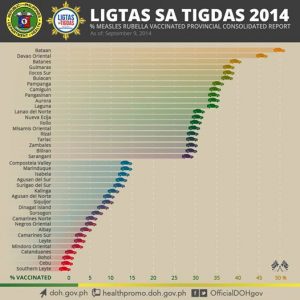In a follow-up to a report in late August concerning a mass measles vaccination campaign that commenced in early September, Department of Health officials are reporting some good success two weeks into the month-long Ligtas sa Tigdas campaign.

Image/Philippines DOH
“We are pleased to announce that we have achieved an overall 44% immunization rate after the second week of the DOH campaign against measles,” Health Undersecretary Janette Loreto Garin declared, adding that other areas need to exert extra efforts to realize their goal.
According to DOH records, the top ten provinces that have immunized their eligible population against measles (54%-64%) are Batanes, Bataan, Cagayan, Davao Oriental, Biliran, Zambales, Nueva Vizcaya, Apayao, Ifugao, and Ilocos Sur. The top ten provinces who have immunized against polio (53%-68%) are Batanes, Biliran, Bataan, Davao Oriental, Cagayan, Nueva Vizcaya, Zambales, Apayao, Ifugao, and Quezon.
Among the cities, the top ten with measles immunization rates ranging from 63% to 84% are: Isabela, Calamba, Gingoog, Meycauyan, Balanga, Urdaneta, Angeles, Pagadian, Valencia, and San Carlos. The top ten cities in oral polio immunization (60%-78%) are: Isabela, Gingoog, Meycauyan, Balanga, Angeles, Urdaneta, Valencia, Pagadian, Calamba, and San Juan., according to a DOH press release today.
At the National Capital Region (NCR), the top performing cities with measles immunization rates from 47% to 62% are San Juan, Navotas, Caloocan, Las Piñas, and Valenzuela. The top five in polio immunization (47%-60%) are San Juan, Las Piñas, Caloocan, Navotas, and Pateros.
On the other hand, the twenty provinces still needing to catch up in their measles and polio immunization campaign are the following: Tawi-Tawi, Maguindanao, Basilan, Sulu, Mindoro Oriental, Palawan, Dinagat Island, Bohol, Camarines Norte, Leyte, Ilocos Norte, Catanduanes, Zamboanga del Norte, Zamboanga Sibugay, Surigao del Norte, Aklan, Surigao del Sur, Cebu, Siquijor, La Union and Albay.
Among the cities, Maasin, Manila, Cagayan de Oro, Calapan, Bais, Dasmariñas, Tanjay, Muntinlupa, Makati, Pasay, Ozamis, Oroquieta, Iriga, Bayawan, Surigao, Calbayog, Vigan, Baguio, Ormoc, Cabadbaran, Bacoor and Puerto Princesa need to work double time to reach their targets in measles and polio immunization. In NCR, those that need to get closer to their goals in their measles and polio vaccination campaign are Manila, Muntinlupa, Makati, Pasay, and Malabon.
Garin explained that the areas where the immunization rates are high can be attributed to the political will and support of their respective local government chiefs, extensive preparatory advocacy activities by health officials, intensified monitoring even before September, more external observers deployed in high-risk areas, the concentration of all DOH efforts on measles alone, and the conduct of a Rapid Coverage Assessment where 20 households are randomly selected and interviewed by a team of national, regional, and provincial monitors and external partners (UNICEF, WHO, Church of the Latter-Day Saints, Japan International Cooperation Agency, Korea Center for Disease Control, US-Center for Disease, WPROEPI- Technical Advisory Group, etc.).
“We encourage other areas to double their efforts to catch up on other cities/provinces as there is still time to reach their goals before the month ends,” Garin urged mothers and caregivers alike.
She explained that among the reasons for the low turnout in these areas are: the eligible child is sick, the child has been vaccinated 4 weeks prior to the start of the campaign, religious or cultural beliefs, some mothers are consulting a private pediatrician, and delay in reporting.
“There is still enough time to reach our goals. The DOH has enough vaccine supply to make the Philippines measles-free and polio-free country,” Garin concluded.
The number of measles cases in the Philippines has been up dramatically in 2014 nationwide. Nationally, the World Health Organization, in their report, “Reported measles cases and incidence rates by WHO Member States 2013, 2014 as of 08 September 2014″, the Philippines has seen 84,738 measles cases to date (43,842 suspected, 40,896 confirmed).
According to the report, only 5,762 confirmed measles cases were reported in 2013.
Another WHO report, the Measles-Rubella Bulletin for Aug. 2014 reports the archipelago as having 60,804 total cases (44,624 suspected and 16,180 confirmed). For more infectious disease news and information, visit and “like” the Infectious Disease News Facebook page


2 thoughts on “Philippines ‘Ligtas sa Tigdas’ Campaign sees success after two weeks”